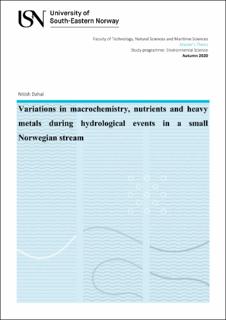| dc.description.abstract | This investigation has emphasized on transport of particles and nutrients during different hydrological events in a water course in Southern Norway, primarily draining agricultural areas. Two streams, Borjaevju and Prestevju, enter artificial made retention dam system (Dam A, B and C) before leaving the dam through the Evjudalen stream. Thus, a major goal was to investigate the retention potential of nutrients, primarily phosphorous (P), in the artificial made dam system. The chemistry in the two streams was very different, with much higher electrolytic conductivity (concentrations of ions) and nutrients in the Prestevju stream compared with the Borjaevju stream.
Anthropogenic influence like agriculture, settlement and sewage discharge may have large impacts on stream water chemistry including turbidity or TSS (Total suspended particles) and subsequent particle associated compounds as TP, heavy metals and organic micropollutants. TSS and turbidity were also strongly and positively correlated with TP in our study. Turbidity and TSS were also strongly positively correlated to water discharge, i.e. at highest during spring and autumn floods, but with significant chemical differences between the two seasonal flood episodes.
Highest concentration of nutrients especially, nitrogen and phosphorus, were observed during spring flood, likely as a result of fertilizing of agricultural land at that time of the year. Despite significant higher turbidity/TSS peak values during the autumn flood, the Total-P was lower than during the spring flood, indicating lower P-particle load during autumn.
Our calculations for retention of particles and particle associated nutrients in the artificial dams, showed retention of turbidity with subsequent retention of TN, TP, Tot-Fe at low to medium flow rates, i.e. up to ≈ 1000 L sec-1measured in the Evjudalen stream located about 200 m downstream from dam area outlet. | en_US |
